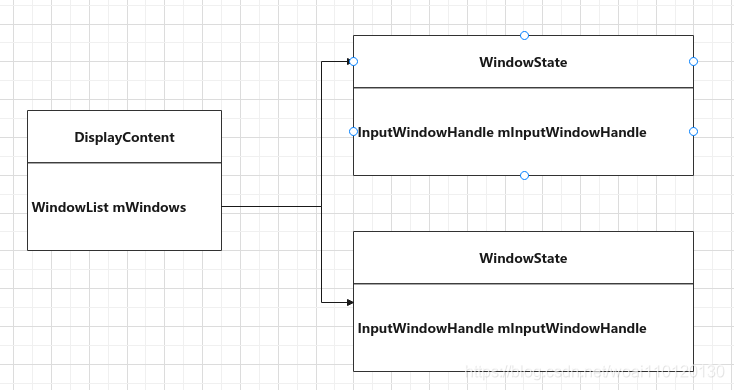在Android InputDispatch事件派发->选择目标窗口一文中我们分析了Android 根据Wms的window信息来派发事件到window对应的应用程序,今天我们来分析下Android如何更新window信息到inputflinger。
当window信息发生变化的时候Wms需要更新window的信息到inputflinger, Android使用InputMonitor.java类来完成操作,InputMonitor 更新window的函数为updateInputWindowsLw。 我们在在Android InputDispatch事件派发->选择目标窗口一文中看到InputDispatcher使用InputWindowHandle代表一个Window,在Wms中由于是java代码,使用InputWindowHandle java类作为inputflinger中InputWindowHandle的对等体。
public final class InputWindowHandle {
// Pointer to the native input window handle.
// This field is lazily initialized via JNI.
@SuppressWarnings("unused")
private long ptr;
// The input application handle.
public final InputApplicationHandle inputApplicationHandle;
// The window manager's window state.
public final Object windowState;
// The input channel associated with the window.
public InputChannel inputChannel;
// The window name.
public String name;
// Window layout params attributes. (WindowManager.LayoutParams)
public int layoutParamsFlags;
public int layoutParamsType;
// Dispatching timeout.
public long dispatchingTimeoutNanos;
// Window frame.
public int frameLeft;
public int frameTop;
public int frameRight;
public int frameBottom;
// Global scaling factor applied to touch events when they are dispatched
// to the window
public float scaleFactor;
// Window touchable region.
public final Region touchableRegion = new Region();
// Window is visible.
public boolean visible;
// Window can receive keys.
public boolean canReceiveKeys;
// Window has focus.
public boolean hasFocus;
// Window has wallpaper. (window is the current wallpaper target)
public boolean hasWallpaper;
// Input event dispatching is paused.
public boolean paused;
// Window layer.
public int layer;
// Id of process and user that owns the window.
public int ownerPid;
public int ownerUid;
// Window input features.
public int inputFeatures;
// Display this input is on.
public final int displayId;
}
Inputflinger和wms中的InputWindowHandle提供的信息是一致的。

Wms把每个屏幕抽象为DisplayContent,每个屏幕上打开的窗口按照层级关系存储再WindowList的集合中,每个Window用WindowState描述状态,WindowState中的mInputWindowHandle则描述了输入相关的窗口信息。updateInputWindowsLw函数就是将窗口信息告知给inputflinger的函数。
/* Updates the cached window information provided to the input dispatcher. */
public void updateInputWindowsLw(boolean force) {
if (!force && !mUpdateInputWindowsNeeded) {
return;
}
mUpdateInputWindowsNeeded = false;
if (false) Slog.d(WindowManagerService.TAG, ">>>>>> ENTERED updateInputWindowsLw");
// Populate the input window list with information about all of the windows that
// could potentially receive input.
// As an optimization, we could try to prune the list of windows but this turns
// out to be difficult because only the native code knows for sure which window
// currently has touch focus.
boolean disableWallpaperTouchEvents = false;
// If there's a drag in flight, provide a pseudowindow to catch drag input
final boolean inDrag = (mService.mDragState != null);
if (inDrag) {
if (WindowManagerService.DEBUG_DRAG) {
Log.d(WindowManagerService.TAG, "Inserting drag window");
}
final InputWindowHandle dragWindowHandle = mService.mDragState.mDragWindowHandle;
if (dragWindowHandle != null) {
// 如果当前正在拖动窗口,将拖动处理的InputHandler添加到mInputWindowHandles中
addInputWindowHandleLw(dragWindowHandle);
} else {
Slog.w(WindowManagerService.TAG, "Drag is in progress but there is no "
+ "drag window handle.");
}
}
boolean addInputConsumerHandle = mService.mInputConsumer != null;
// Add all windows on the default display.
final int numDisplays = mService.mDisplayContents.size();
// 遍历所有的屏幕下的所有窗口
for (int displayNdx = 0; displayNdx < numDisplays; ++displayNdx) {
WindowList windows = mService.mDisplayContents.valueAt(displayNdx).getWindowList();
for (int winNdx = windows.size() - 1; winNdx >= 0; --winNdx) {
final WindowState child = windows.get(winNdx);
final InputChannel inputChannel = child.mInputChannel;
final InputWindowHandle inputWindowHandle = child.mInputWindowHandle;
if (inputChannel == null || inputWindowHandle == null || child.mRemoved) {
// Skip this window because it cannot possibly receive input.
// 跳过不能处理input事件的窗口
continue;
}
// 添加mInputConsumer到mInputWindowHandles列表,注意会根据层级添加到合适的位置
if (addInputConsumerHandle
&& inputWindowHandle.layer <= mService.mInputConsumer.mWindowHandle.layer) {
addInputWindowHandleLw(mService.mInputConsumer.mWindowHandle);
addInputConsumerHandle = false;
}
final int flags = child.mAttrs.flags;
final int privateFlags = child.mAttrs.privateFlags;
final int type = child.mAttrs.type;
final boolean hasFocus = (child == mInputFocus);
final boolean isVisible = child.isVisibleLw();
if ((privateFlags
& WindowManager.LayoutParams.PRIVATE_FLAG_DISABLE_WALLPAPER_TOUCH_EVENTS)
!= 0) {
// 如果上面有window进制将事件发送给墙纸窗口,则后续都不允许将事件发送给壁纸窗口
disableWallpaperTouchEvents = true;
}
final boolean hasWallpaper = (child == mService.mWallpaperTarget)
&& (privateFlags & WindowManager.LayoutParams.PRIVATE_FLAG_KEYGUARD) == 0
&& !disableWallpaperTouchEvents;
final boolean onDefaultDisplay = (child.getDisplayId() == Display.DEFAULT_DISPLAY);
// If there's a drag in progress and 'child' is a potential drop target,
// make sure it's been told about the drag
if (inDrag && isVisible && onDefaultDisplay) {
mService.mDragState.sendDragStartedIfNeededLw(child);
}
// 添加window到mInputWindowHandles
addInputWindowHandleLw(inputWindowHandle, child, flags, type, isVisible, hasFocus,
hasWallpaper);
}
}
// 提交窗口信息到inputflinger
// Send windows to native code.
mService.mInputManager.setInputWindows(mInputWindowHandles);
// Clear the list in preparation for the next round.
// 清空
clearInputWindowHandlesLw();
if (false) Slog.d(WindowManagerService.TAG, "<<<<<<< EXITED updateInputWindowsLw");
}
updateInputWindowsLw函数整个流程不太复杂,整个过程主要做的工作就是按照从高到低的顺序收集窗口信息到mInputWindowHandles描述的数组中,添加窗口到mInputWindowHandles使用的函数为addInputWindowHandleLw函数。当收集完所有窗口信息后,通过mService.mInputManager.setInputWindows(mInputWindowHandles)同步窗口信息给inputflinger。最后调用clearInputWindowHandlesLw()函数来清空mInputWindowHandles,方便下一轮收集。在收集window的过程中有两个特殊的window,第一个是mService.mDragState.mDragWindowHandle,用于处理window拖动的情况。另外一个是mService.mInputConsumer.mWindowHandle,处于在应用进入全屏模式下拦截事件。比如全屏播放视频的时候,触摸窗口会将导航栏显示出来,就是通过这个window来接收的输入事件,进行处理。





















 1198
1198











 被折叠的 条评论
为什么被折叠?
被折叠的 条评论
为什么被折叠?








